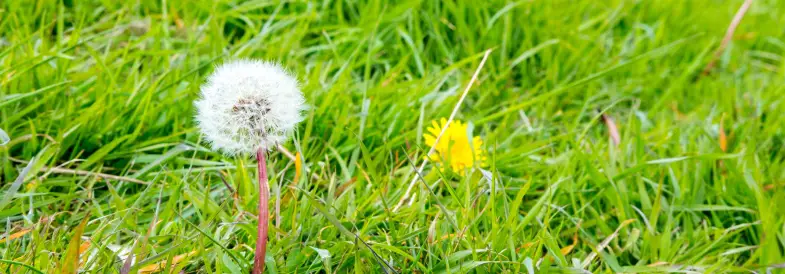Most homeowners have to battle dandelions in their yards at least two times a year if not to a lesser degree throughout the summer as well. For the most part these weeds are not bad for your lawn but they are unsightly and they can get worse year after year if you don’t do anything to kill them.
Luckily killing dandelions isn’t hard and if you do it at the right time of the year it can be a simple chore that is easier every time the dandelion season comes around.
Dandelions are perennials that bloom heavily in the Spring and Fall, they may bloom to a lesser degree during the summer months as well but by late fall their energy is transferred to their deep tap root where they go dormant for the cold season. If you spray post-emergent herbicide in early to mid-autumn most of the dandelions will die off quickly and the tap roots will not be able to survive the winter.
For the most part pre-emergent herbicides will not affect the growth of new dandelions or the re-emergence of existing dandelions but similar post-emergent spot applications in the early to mid-Spring can limit the amount of these weeds growing in the lawn as well.
It may be tempting to use weed-and-feed type products to apply blanket applications on an entire lawn space but usually this practice is unnecessary and leads to excess chemicals in the lawn. By opting to spot spray individual weeds that emerge in the fall or spring you can kill emerging weeds as they start growing and use far less chemicals in the process.
Most people trying to get rid of large dandelion infestations will start with 2-4D herbicides which are very effective at killing dandelion weeds in just a few days at most. After the weeds are under control some homeowners then opt to switch over to non-chemical based weed killers such as horticultural vinegar which is a non-selective method, meaning it will kill anything it touches, including grass.
This is a valid option for controlling dandelions because most lawns can recover from a dead patch of grass over time with little intervention on your part.
With that out of the way let’s discuss the actual timing of post-emergent dandelion control as well as the products you can use. Finally we’ll wrap up with more information on managing dandelions throughout the season by following good maintenance practices and applying organic supplemental products.
Reasons to Get Rid of the Dandelion Plant
Many people are proponents of leaving dandelions alone for a number of reasons. The main one’s being that they are not bad for a lawn, they are edible, and that they rarely take over a lawn that is being maintained regularly.
For people that mow regularly, fertilize their lawns, and apply pre-emergents in the spring to control other types of common weeds and undesirable grasses most dandelions that crop up are hardly noticeable and will get cut back over and over during your weekly mowing schedule.
For those that believe that these weeds are really ugly then that alone is why we get rid of them. Usually larger patches of dandelion weeds indicate poor soil or poor turfgrass coverage. It can be easier to improve the soil and grass in an area when it’s not covered in dandelion foliage.
So to remove them from an area will usually require one of only two things, hand removal, or herbicidal removal.
Most Common Ways to Remove Dandelions
If you really cannot put up seeing dandelion flowers on your lawn, then there are few ways to go about this. You can either decide to hand pluck, go more traditional, or use herbicides.
#1. How to Dig Them Up By Hand
If you really hate seeing those yellow dandelion flowers, then you should probably go for this first method only if you have a small amount of them in your lawn and you don’t mind digging large holes in the lawn and repairing them after the fact.
Hand digging dandelions out will ensure that they won’t come back again however getting all of the tap root can be challenging because they are brittle and can stretch over a foot deep. To pull out established weeds can mean digging a pretty big hole in the ground. Untouched a dandelion plant can live for over ten years so that tap root can be quite big.
The truth is, if these wild and colorful plants are not dealt with from their roots, you’ll most likely see them resurface soon enough and that’s why so many people decide to kill them with herbicides. Digging them out can be so laborious and you are rarely sure you got all the root when digging.
It’s preferable to pluck out dandelion flowers and roots in spring. This is usually the time when the first dandelion seedlings come. You should use tools like “dandelion pullers” to dig. They can help the process.
#2. How To Kill Dandelions With Post-Emergent Herbicides
Of course, you probably already knew this but attacking your dandelions with a post-emergent herbicide is way quicker and less stressful. Most dandelions will die very easily when a 2-4D product is spot sprayed directly on their leafs during the growing season.
There are lots of post-emergent products on the market that can be applied to an entire lawn space but I believe it’s far better to just mix up a concentrate with water in a spot sprayer and apply only to the weeds as they emerge.
You would be surprised at how effective this method is and how easy it is to nearly eliminate dandelions from a lawn in a single season taking this approach.
Remember, most dandelions in the lawn have lived under the soil for multiple seasons. Pulling them often leaves the tap root which can and will likely grow back. By killing the weed with an herbicide the plant will never return and new seeds will never crop up unless they come from your neighbor’s property.
A single dandelion seed head “puff ball” can spread over a hundred seeds at once. Stopping this pattern over the course of a single season will make a huge difference in your lawn in subsequent seasons.
If you take this route your next biggest challenge will be in choosing the product to apply and the sprayer to apply it, both of which however should be easy and inexpensive decisions to make.
#3. Go Traditional
If you don’t want to use any of the methods above to deal with this weed, then you could face it head-on by pouring boiling water on them or by applying horticultural vinegar which can kill them just the same. Salt will do it too but there will be consequences in taking these steps. These methods will kill the grass too and can damage the soil structure for a significant amount of time meaning it will take a long time for the lawn to recover in the area where the weed once lived.
What About Just Mowing Them Regularly? Are There Any Benefits to Keeping Some Dandelions In Your Lawn?
This may be news to you but dandelions can actually be good for your lawn. Their deep taproots helps to loosen compacted soil by burrowing deep and wide into the ground. They help to aerate the soil and reduce the possibility of soil erosion in those areas where your turfgrass is thin.
That isn’t all, while their roots might normally seem like an issue of concern to you, they do help in enriching your turfgrass. By digging deep into the soil, its taproot absorbs essential nutrients and brings it to the surface where the turfgrass can access it.
In fact I’ve got an entire post here on this topic: Are Dandelions Bad For The Grass?
Here Are A Few More Benefits of Not Killing Off Your Dandelions
Dandelions are not only beneficial to your lawn. They are useful to you and other living organisms around you. They serve as a food source to birds, insects and other flying and ground insects alike.
The dandelion flower is usually one of the first plants to bloom during spring. And so, they become an essential food source for pollinators who are newly emerging from winter dormancy. The dandelion plant is believed to provide pollen and nectar for about 100 different species of insects as well.
Its seeds also serve as a food source to over 30 different species of squirrels, birds, chipmunks, and other small critters.
The dandelion plant isn’t only great for insects and birds; it also offers unrivaled medicinal and health benefits to humans. Everything from its leaves to its roots is edible for humans. Feel free to give up conventional coffee or tea with this plant. And don’t forget that you can spice up your salads with this plant as well.
Of course all of those things usually come in second to aesthetics for most homeowners so if you do choose to get rid of your dandelion patch then let’s cover the various types of post-emergent products you can use safely in the lawn.
Types of Herbicides That Can be Used To kill Dandelions
Dandelioon killers will broadly fall under two different categories of products. You will have to decide to go for either a selective broadleaf herbicide or a non-selective herbicide which are capable of killing off most types of vegetation regardless of the desirability of said vegetation.
If you were to choose either a 2, 4-D or an Iron HEDTA (FeHEDTA) herbicide either would work to eliminate many different types of broadleaf weeds including dandelions without harming most types of turf grasses. Basically the selective nature of the product will save the grass or lawn around the offending weed whereas non-selective herbicides like a glyphosate product will kill any plant in sight including your lawn.
While you might already be concluding that non-selective herbicides are of no good, they are indeed perfect for on the spot removal of dandelions and work great for controlling undesirable foliage in areas like landscape beds, fence lines, or any other place where you don’t want any vegetation of any kind.
For starters to post-emergent dandelion control I usually recommend readers to opt for Ortho’s WeedClear Lawn Weed Killer which comes in a ready-to-use container complete with an attached the battery wand for precise spot spraying.
There are other products however that may make more sense for you.
When Is the Best Time to Spray Dandelions
As previously discussed it’s generally preferable to apply these types of products in the spring or during the middle of fall before things go to sleep for the winter.
In addition to these seasonal best practices it’s also best to spray these products in the late morning or in the early evening on dry warm days. These products work best when applied directly to the leaf surface of the weeds and when they are dry and warm they get absorbed more efficiently and will be less likely to runoff or otherwise not work.
Spraying your dandelions during the fall normally produces the best results because the plants are beginning to send their energy down to the root zone in preparation for winter instead of sending their energy into new growth. When you can guarantee the herbicides are going to make it into the tap roots then you can be sure they will die off quickly and without trouble.
Additionally you should try treat as many weeds as possible as early in their growth cycle as possible. Herbicides are most effective on dandelions and other broadleaf weeds when they are small and still actively maturing. They will also work best when applied before the weed begins to develop flowers.
Once you begin noticing dandelion flowers on your lawn, it might be an indication that you’ll have more work trying to resist them.

